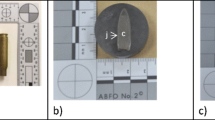Abstract
A design feature for non-lead bullets was proposed enabling visual distinction from lead-core bullets. The feature would allow rapid, non-invasive, examination of ammunition to ensure compliance with lead-free bullet regulations. The feature entails making symmetric flutes, or concentric rings, behind the bullet tip during manufacture. They are unlikely to affect bullets’ ballistic performance. Should the design be adopted, agreement among governmental agencies and bullet makers is essential to incorporate this design protocol into regulations.


Similar content being viewed by others
Notes
Containing a maximum 1 % lead (California Department of Fish and Wildlife 2015).
References
California Department of Fish and Wildlife (2015) Nonlead certification information for ammo manufacturers. California Department of Fish and Wildlife, Sacramento, California, USA. URL http://www.dfg.ca.gov/ wildlife/hunting/lead-free/certification.ht
CGerLI (2008) Centre for German Legal Information. URL http://www.cgerli.org/fileadmin/user_upload/interne_Dokumente/legislation/BJagdG2008.pdf
Golden NH, Warner SE, Coffey MJ (2016) A review and assessment of spent lead ammunition and its exposure and effects to scavenging birds in the United States. In: de Voogt P (ed) Reviews of Environmental Contamination and Toxicology 237:123-191. doi:10.1007/978-3-319-23573-8-6
Gremse C, Rieger S (2015) Lead from hunting ammunition in wild game meat: research initiatives and current legislation in Germany and the EU. In: Delahay RJ, Spray CJ (eds) Proceedings of the Oxford Lead Symposium. Lead ammunition: understanding and minimising the risks to human and environmental health. Edward Grey Institute, Oxford, pp 51–57
Thomas VG (2013) Lead-free hunting rifle ammunition: product availability, price, effectiveness, and role in global wildlife conservation. AMBIO 42(6):737–745. doi:10.1007/s13280-012-0361-7
Thomas VG (2009) The policy and legislative dimensions of nontoxic shot and bullet use in North America. In: Watson RT, Fuller M, Pokras M, Hunt WG (eds) Ingestion of lead from spent ammunition: implications for wildlife and humans. The Peregrine Fund, Boise, pp 351–362. doi:10.4080/ilsa.2009.0311
Watson RT, Fuller M, Pokras M, Hunt WG (eds) (2009) Ingestion of lead from spent ammunition: implications for wildlife and humans. The Peregrine Fund, Boise
Acknowledgments
This paper was produced with the personal funds of the author.
Author information
Authors and Affiliations
Corresponding author
Ethics declarations
Conflict of interest
The author declares that he has no conflict of interest.
Rights and permissions
About this article
Cite this article
Thomas, V.G. Design of non-lead rifle bullets to allow instant identification. Eur J Wildl Res 62, 771–774 (2016). https://doi.org/10.1007/s10344-016-1045-6
Received:
Revised:
Accepted:
Published:
Issue Date:
DOI: https://doi.org/10.1007/s10344-016-1045-6




